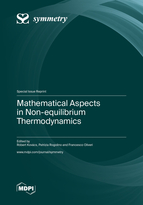Mathematical Aspects in Non-equilibrium Thermodynamics
A special issue of Symmetry (ISSN 2073-8994). This special issue belongs to the section "Mathematics".
Deadline for manuscript submissions: closed (15 June 2022) | Viewed by 11093
Special Issue Editors
2. Institute for Particle and Nuclear Physics, Theoretical Physics Department, Gravitational Physics Research Group, Wigner Research Centre for Physics, Budapest, Hungary
Interests: non-equilibrium thermodynamics of heat conduction (low temperature, biological applications) and rarefied gases; analytical and numerical methods
Special Issues, Collections and Topics in MDPI journals
Interests: non-equilibrium thermodynamics of heat conduction; graded materials; thermoelectricity; analytical and numerical methods
Special Issue Information
Dear Colleagues,
Non-equilibrium thermodynamics is a relatively new field of research and beginning to be increasingly important in engineering applications as well. However, in addition to the many approaches developed in recent decades, all of them raise questions from a mathematical point of view, such as the proper definitions of initial and boundary conditions, analytical and numerical solution methods, as well as the geometrical background, which is a very interesting aspect.
These questions cover numerous topics, such as the mathematical analysis of various thermodynamic approaches, the investigation of the resulting governing equations, symmetry analysis of the solutions, and how the numerical methods can be built on the geometrical background.
The aim of this Special Issue is to offer the possibility to discuss and present up-to-date problems that may not be constrained only to the previously mentioned aspects but must be connected to non-equilibrium thermodynamics.
Thus, in the present Special Issue, we aim to collect open mathematical questions and characteristics for different thermodynamic approaches; therefore, both original and review papers are welcome.
Dr. Kovács Róbert
Prof. Dr. Patrizia Rogolino
Prof. Dr. Francesco Oliveri
Guest Editors
Manuscript Submission Information
Manuscripts should be submitted online at www.mdpi.com by registering and logging in to this website. Once you are registered, click here to go to the submission form. Manuscripts can be submitted until the deadline. All submissions that pass pre-check are peer-reviewed. Accepted papers will be published continuously in the journal (as soon as accepted) and will be listed together on the special issue website. Research articles, review articles as well as short communications are invited. For planned papers, a title and short abstract (about 100 words) can be sent to the Editorial Office for announcement on this website.
Submitted manuscripts should not have been published previously, nor be under consideration for publication elsewhere (except conference proceedings papers). All manuscripts are thoroughly refereed through a single-blind peer-review process. A guide for authors and other relevant information for submission of manuscripts is available on the Instructions for Authors page. Symmetry is an international peer-reviewed open access monthly journal published by MDPI.
Please visit the Instructions for Authors page before submitting a manuscript. The Article Processing Charge (APC) for publication in this open access journal is 2400 CHF (Swiss Francs). Submitted papers should be well formatted and use good English. Authors may use MDPI's English editing service prior to publication or during author revisions.
Keywords
- non-equilibrium thermodynamics
- analytical and numerical solutions
- different thermodynamical approaches






